We are heading north again. Last night we crossed the Antarctic Circle on the return trip. The air was in full blizzard, visibility zero, but we felt it when we hit the line with the ship. Well, Ken Halanych said he did, anyway. No secret handshakes, no whizzers and bugle horns. Just another blip on the radar.
Today I give way to the voice of Dr. Rudi Scheltema, who has worked painstakingly on a brief description of how this cruise came to be. It is important for those out there who are pursuing a science career to know a bit about the process of scientific research. That process doesn’t always take 12 years to brew, but you can imagine how things never go according to a Perfect Plan always be ready with a Plan B and don’t give up your dream! Sometimes the tiniest window can lead to opening a very big door.
Why We Are Here
[or, “Science is Slow, So Live Long”] by R. Scheltema May-June/06
Perhaps some may wonder how the present expedition had its origin in a project that includes twenty participants to test a hypothesis conceived 12 years ago. In late fall 1994 there were a few berths available on the R.V.POLAR DUKE , a Norwegian ship leased by the National Science Foundation for work in Antarctic waters. It was an expedition by R. Harbison of the Woods Hole Oceanographic Institution (WHOI) to find salps in the waters north of the South Shetland Islands. I (Rudi Scheltema) with my Research Associate, Isabelle “Izzie” Williams, took up the offer. We packed a plankton net and two relic microscopes and proposed to look for the larvae of benthic invertebrate species upon which there then was very little known for the region of the South Shetland Islands. We were surprised to encounter in almost every plankton tow some larvae of benthic marine invertebrates, including those of polychaete and nemertine worms and often those of sea and brittle stars as well.
The four week experience in the Antarctic led me to the library to see what was known about the geological history and biogeography of the Antarctic. I discovered that the continents of South America and Antarctica had been isolated from one another by Drake Passage somewhere between 30 and 40 million years, and it struck me that over this geologic period invertebrates could have changed on either or both continents, or that Antarctica might have evolved a unique fauna. This turned out to be true for most taxa (i.e. groups of marine bottom invertebrates), but there were important exceptions, namely polychaete worms, sea stars and brittle stars. We proposed that there must be some connection between the non-endemism and the occurrence of planktonic larvae in the life history of a species. The non-endemism coincided with those taxa which had planktonic larvae.
During 1996 and 1998, I wrote two comprehensive proposals to pursue this hypothesis. Both were declined. Then in 1999, though the second proposal was declined, I was encouraged by a rotating program associate director at NSF to write a five-page summary of what I wanted to do, and was awarded a “small grant for exploratory research (SGER)”. This allowed Izzie and me to join a voyage to Antarctica in 2000. I invited Ken Halanych of the biology department at WHOI (now at Auburn University), and Heidi Fuchs, a graduate student (now with Scripps Institution of Oceanography), making us a team of four. Although we had planned to take plankton samples across Drake Passage at four hour intervals it turned out through an administrative accident that we had no permission to work in Argentine waters. This prevented our staring our line of stations until we reached 59º South latitude, close to half the distance between South America and Antarctica. We did extensive sampling in the northern half of Bransfield Passage and between King George Island and Elephant Island. It was difficult to keep up with the sorting of plankton samples. We obtained an extension on our exploratory grant in 2001, this time to sample across the entire width of the Drake Passage from Staten Island to the shore of Antarctica along longitude 65ºW. This time our party was increased to 10, including the four of us from the previous voyage plus six additional students and scientists. Ken Halanych, with benthic interests, was able to take a few bottom dredge samples. Initially this was to enable us to connect the larvae encountered to their adult forms. After two complete crossings of the Drake Passage, we were able to demonstrate that larvae of benthic invertebrates could be found far out at sea.
In 2003, Halanych and I wrote a cooperative grant proposal to further work on the hypothesis that long-distance dispersal could explain a genetic connection of non-endemic species and the co-occurrence of species on the continent of South America and Antarctica. This larger grant provided funds for both of us: to me for confirming larval transport across Drake Passage and to consider the oceanography of Drake Passage in relationship to the larval dispersal; and to Halanych to explore the use of molecular techniques in relating bottom invertebrate species to their larvae. Ken enlarged the dredging efforts with the idea of relating the similarities and differences of bottom communities in Antarctica and how larval dispersal might affect such differences and similarities.
On this new grant, we were allowed two expeditions. The first was made during the austral summer of 2004 which we shared the ship with L. Madin of WHOI, who was investigating salps. Our party consisted of fifteen, and Madin had seven.
In the current expedition, five expeditions later, we are a team of 20. The realm of our concepts has also grown. The area of our research has enlarged from evolutionary considerations, biogeography, and larval dispersal, to possible genetic relationships between continents and Antarctic populations.
Each voyage of a research vessel to the Antarctic is made up of men and women with a variety of skills; by scientists, technicians, students, seamen, engineers, cooks and by those that keep the ship clean and safe. The ideas of 1994 have grown in scope and in the numbers of individuals, each contributing to making the voyage a success. In their own way they are making the research possible, participating in the demanding effort of collecting samples to support the original vision. What you see in many of this Journal’s articles is the result of this vision conceived 12 years go.
Getting to Know You
Dr. Rudolf Scheltema
Rudi Scheltema’s scientific inquisitiveness started right at the source his own back yard. Spurred by his father, himself a botanist, he identified and learned the names (including the Latin) of the trees surrounding his home in rural Maryland. He also had a close friend who collected bugs, mostly butterflies. The chord was struck and Rudi heard the melody, yet in the distance. When he returned from armed service during WWII, he went to college at George Washington University for a degree in Zoology. Although required to take core courses, he figures more than half were in invertebrate zoology. He remembers taking the train from Washington all the way to Woods Hole, first to take the ferry to Nantucket with family, and later on during college, to take summer courses in invertebrate zoology, algae and marine ecology at the Marine Biological Laboratory (MBL, now and forever after). He remembers those courses fondly, for having the wonderful, enthusiastic teachers, and the hands on experience they offered. They looked at live organisms from every major group in their actual habitat (are you seeing the genesis of a theme here?)!
There was a short but life-altering stint at Harvard University as Rudi pursued his PhD. (He had formulated and proposed his PhD thesis in 6 short weeks.) Perhaps there was a course or two he really enjoyed, but this is where he met Amelie, with whom he would form a bond, marry and create a match rarely seen. When he became dissatisfied with the lack of a suitable advisor at Harvard, he and Ami followed a path (through a Woods Hole professor) to the University of N. Carolina. It was there that he finished his PhD in Zoology. His first professional job was in New Jersey through Rutgers U. in a remote lab studying disease in oysters. After a year of “looking at little things that my supervisor imagined were there”, he accepted a job offer from Nat Turner, a scientist in of all places Woods Hole. He had met Turner when he taught one of those MBL summer courses, and through time spent in a small lab in the basement of the Bigelow Building at WHOI, Rudi forged his future on the straightest path I have ever known in the development of a professional career.
Now on the scientific staff at WHOI, the next tier of scientific pursuit was with two other WHOI scientists, Howard Sanders and Bob Hessler. Rudi says “Doing laboratory experiments and making observations in the natural world are two different things.” You might come to understand certain things better, but you don’t see in the lab what you see when you go on site. It made sense that larvae watched in a lab setting might behave quite differently out in their own habitat. He became more and more an ‘at sea’ kind of scientist, finding a niche in ships going to sea for science whenever he could. His interest evolved to understanding the ‘settling’ process of larvae what was the cue for larvae to settle and begin metamorphosis to become an adult? (Ed. note: Rudi, parents of older adolescents have been looking for the secret to that since vertebrates first crawled out of the ocean!) In 1969 Izzie Williams went to work in the Scheltema Lab and has been an invaluable collaborator on the many grants and explorations into the world of larvae since that time. Rudi credits much of his success to the association he has with Izzie.
If you would like to engage in a rousing debate, ask Rudi for his thoughts on the premise that “Science and technology are not the same!”
Rudi and Ami have two sons, Charlie and Conrad, and three lovely grandsons. Today, Rudi and his beloved bride, Ami, celebrate (albeit ~12,500 kilometers apart) 51 years of marriage.
Back to the Science
Haven’t you had enough for today?
Don't hesitate to email
questions to us at outreach@lmg.usap.gov
|
|
Longitude/Latitude:
S65° 39.907’ W68° 04.293’
Temperature:
Wind: SW 6-8kn
Air Temp: -2.6°C
Wind Chill: -6.6°C
Surface Water Temp: -0.343°C
Menu:
Boneless Pork loin chops, beef and noodles, cauliflower, peas and mushrooms, corn chowder; spaghetti, chix Parmesan, okra, butter beans, cake, McCaroons, rice pudding, vanilla pudding, strawberries and whipped cream, ice cream, and cookies.
Photos:
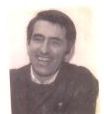


Dr. Rudolf Scheltema
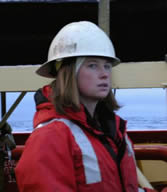
Auburn U. Senior Nicole Cox on deck for the benthic trawl.
[Photo by E. Bailey]

A snow petrel takes a snooze by the Wet Lab door. [Photo by E. Bailey]
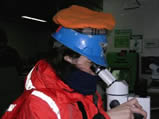
Could Alex Eaves’ mind be totally on her science?? [Photo by E. Bailey]
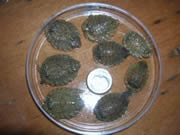
“But, Mahhh-ahm, they’re so ky-oooooot!” Dish o’ isopods. [Photo by E. Bailey]
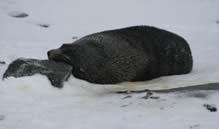
Origin of “I was so tired, I slept like a rock!!” [Photo by Susie Balser]
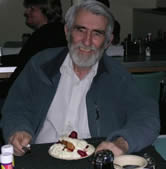
“Happy Anniversary, Ami!” (These are not Coonamessett Farm strawberries, but, well…) [Photo by E. Bailey]
|










